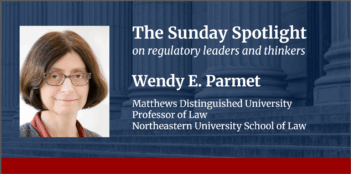
The Regulatory Review’s global COVID-19 series offers valuable lessons that can help improve administrative law and policy.
The COVID-19 pandemic and its second-order economic effects constitute a historic, worldwide crisis—one that is only in its early stages, but already points to long-term effects that are sure to be deep and lasting. In time, the crisis will reach every aspect of human society, and scholars of every discipline will need to reckon with its implications.
For legal scholars, there is already much to reflect upon, including, but not limited to, the use of emergency powers in various jurisdictions, the failings and potential usefulness of international law, and the particular human rights burdens the crisis has levied.
The contributions made to The Regulatory Review’s series, “Comparing Nations’ Responses to COVID-19,” touch on all of the above issues. But these essays stand out for their primary attention to the administrative law and regulatory dimensions of the present crisis in each of the nations covered. Under that general rubric, the essays address a broad range of issues, including the initial detection and reporting of the coronavirus, subsequent efforts to mitigate its threat to public health and safety, and the mechanics of present or future attempts to reopen locked-down economies.
Irrespective of how nations delegate regulatory power to their government officials, the manner in which those officials exercise their authority when confronting particular crises, such as COVID-19, is a matter of shared and profound importance. It is upon this terrain of administrative law and policymaking that citizens are most likely to judge their governments. It is here where national leaders’ political legitimacy ultimately rests.
In the United States, recent years have been marked by “a resurgence of the antiregulatory and antigovernment forces that lost the battle of the New Deal.” Under the Trump Administration, this resurgence has taken the form of regulatory rollbacks under the Congressional Review Act and slowdowns in the issuance of “economically significant” rules; the appointment of an unusually large number of acting officials to the highest level of government; and the annual pursuit of steep cuts in funding for social welfare agencies. Coupled with sharp rhetorical attacks on the so-called “deep state,” these policies and others like them have no doubt helped to keep public trust in government at historic lows.
Recent antiregulatory efforts have also gathered steam in other liberal democratic countries—often in connection with the ascendance of right-wing populist movements. The United Kingdom’s departure from the European Union was marketed, in large part, as a way to unshackle the British economy from the burden of European regulations. Although Brexit itself remains an anomaly—for now—that same antiregulatory vision has been prominent in the discourse of Matteo Salvini (former deputy Prime Minister) in Italy, Marine Le Pen (President of the National Rally Party) in France, and Geert Wilders (parliamentary leader of the Party for Freedom) in the Netherlands, among others. Newly elected governmental leaders, such as Scott Morrison in Australia and Jair Bolsonaro in Brazil, have made aggressive deregulation, especially concerning environmental protection, a centerpiece of their political agendas over the past few years.
In those democracies where the regulation of public health, safety, and welfare is most under siege, it appears that the mitigation response to the COVID-19 pandemic has been especially poor. Contributions to this series document regulatory breakdowns in nations such as the United States, the United Kingdom, and Brazil, all of which have dramatically failed to contain the spread of the coronavirus. These failures flow naturally from the antiregulatory trends discussed above—which continue unabated.
Meanwhile, the initial failure of Chinese authorities to detect and report coronavirus cases after the virus emerged in the city of Wuhan—a failure addressed in this series by one of China’s leading administrative law scholars—has been overshadowed, to a surprising degree, by the relative effectiveness of later containment efforts in the country. For comparative scholars, this juxtaposition of performances by democratic and authoritarian regimes raises uncomfortable questions about different governance models in the face of public health or other crises—just as authoritarian governments seem to be utilizing the pandemic to strengthen illiberal powers, and more than a few democracies, including Australia, India, and Israel, are taking steps in the same direction.
These questions become even more complicated when we take a broader look at how other nations have responded to COVID-19. A number of liberal democracies—including Germany, South Korea, Taiwan, and New Zealand—have managed to avoid autocratic tactics, and remain true to their own governance principles, while successfully containing their nations’ viral infection rates. At the same time, some autocracies, such as Russia and Iran, continue to struggle with the coronavirus, notwithstanding the robust surveillance and other control tools at their disposal, similar to those deployed in China. And for other autocratic regimes, including Vietnam and Singapore, their relative success in managing the pandemic appears to rest, instead, on non-autocratic elements of their governance models—more open and transparent regulation in the case of Vietnam, and carefully restricted emergency measures in the case of Singapore.
The essays in this series may not resolve debates over the relative merits and efficacies of regime type in times of crisis. However, in the impressive range of the collection—and the granularity of each contribution—there is much to be gleaned about state regulatory capacity overall. In addition, the series reveals the precise regulatory challenges that nations may share in common, as well as those regulatory tools or approaches that may be transferable across jurisdictions, notwithstanding political or cultural differences.
One clear theme that comes across in many of the essays is the importance of robust coordination between, and among, federal, state, and local regulatory authorities to achieve effective pandemic response. This lesson is noted both when such coordination is absent, as demonstrated by South Africa, the Netherlands, Switzerland, Mexico, Brazil, and the United States; and when coordination is present, as revealed in South Korea, Germany, and—eventually—Italy.
Another cross-cutting theme in the series centers on the relative primacy afforded to scientific expertise and evidence-based risk management in different jurisdictions. This is a regulatory variable found especially wanting in France and Chile, for example, and with serious adverse consequences for yet a third important factor, public trust. The level of public trust, in turn, appears inversely correlated to the stringency of regulation that may be required to secure desired compliance, as demonstrated by the cases of Taiwan and Japan.
As scholars, policymakers, and even members of the public grapple further with these themes, the essays in this series are sure to underscore additional connections and yield deeper insights. As an exercise in comparative administrative law, the series builds on a rich tradition founded upon Frank Goodnow’s direction that “only by study, and by comparison of our own with foreign administrative methods” can we adequately meet the “enormous demands of the administrative side of the government [posed by] our modern complex social conditions.” Goodnow’s perspective gained traction in the immediate aftermath of World War II, arguably the last shared global experience analogous to the present moment, and likewise carries new relevance today.
Hopefully, any lessons learned from this comparative exercise will feed into dynamics of regulatory competition across jurisdictional boundaries—and escape the bonds of “exceptionalist” national thinking—to drive a “race to the top,” establishing effective regulatory management of the COVID-19 pandemic. Indeed, regulatory competition between nations has produced such meaningful change to domestic regulation in the past, and could do so again.
Even more optimistically, as scholars and policymakers increasingly recognize the negative spillover effects that regulatory failures associated with the coronavirus can have on other nations—yet another lesson this series highlights—the COVID-19 crisis may renew momentum from the past decade toward international regulatory cooperation.
As the world continues to struggle with the “very long tail of negative political consequences” set in motion by the global financial crisis of 2008—and worsened by the current pandemic—let us hope that this series, and further scholarship it inspires, can play a useful role toward improving nations’ regulatory responses to global crises, now and in the future.
The author thanks Lucas Siegmund and Meghan Downey, both Penn Law ’21, for helpful edits to this essay, as well as their extraordinary stewardship over the series as a whole.
This essay is part of an ongoing series, entitled Comparing Nations’ Responses to COVID-19.




